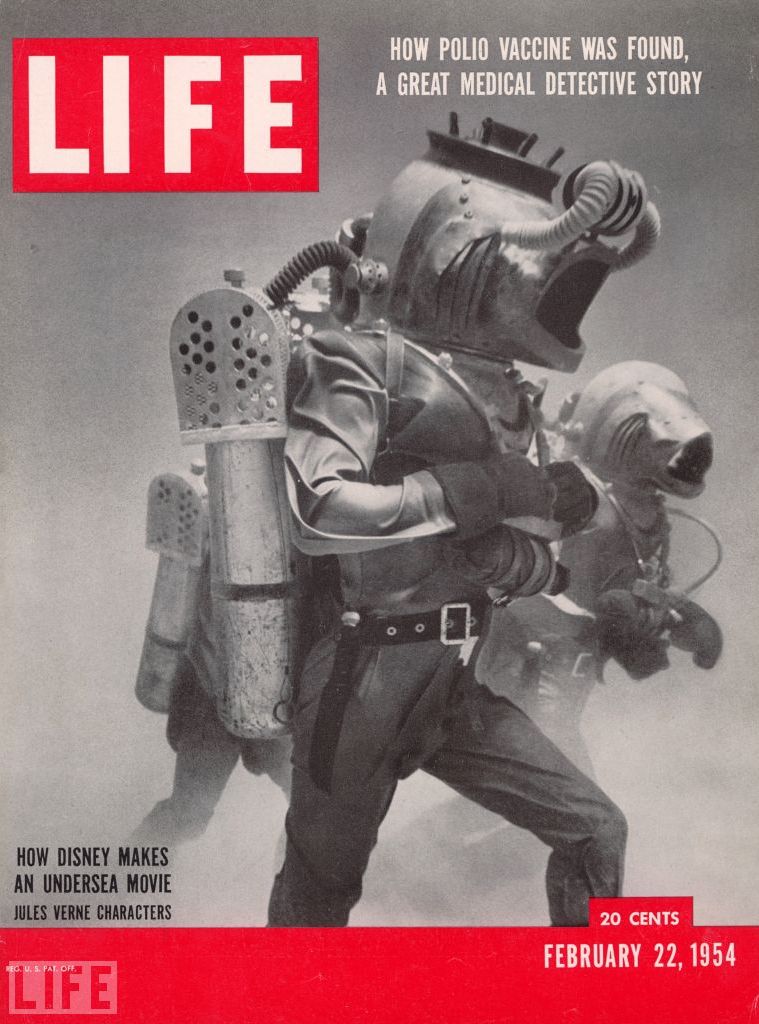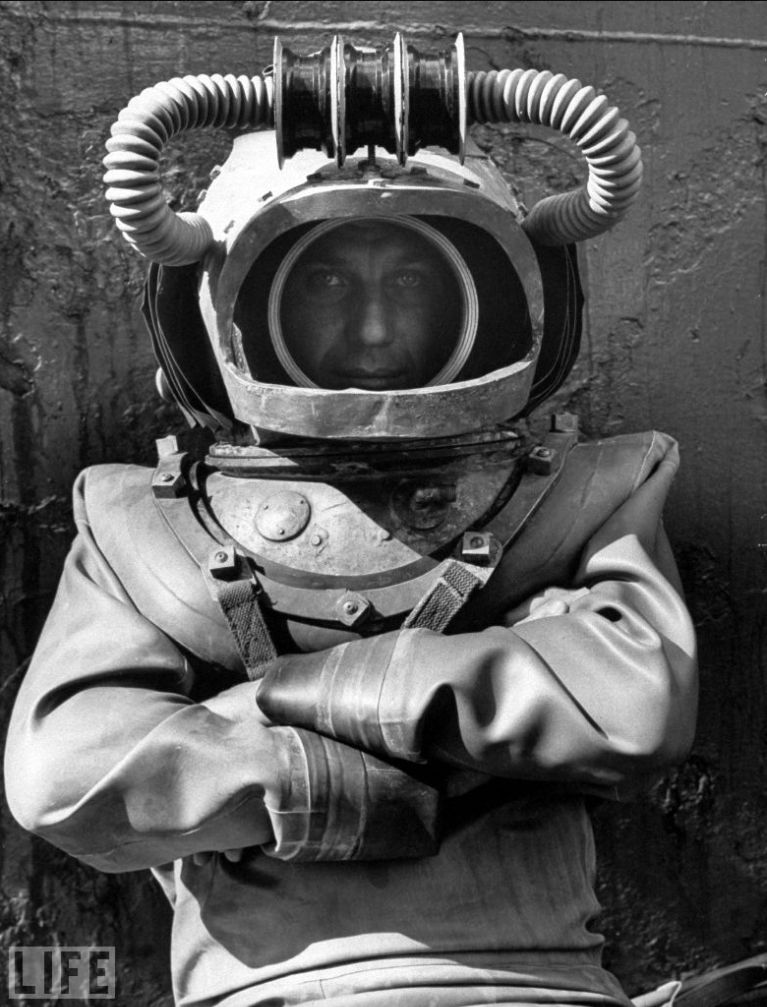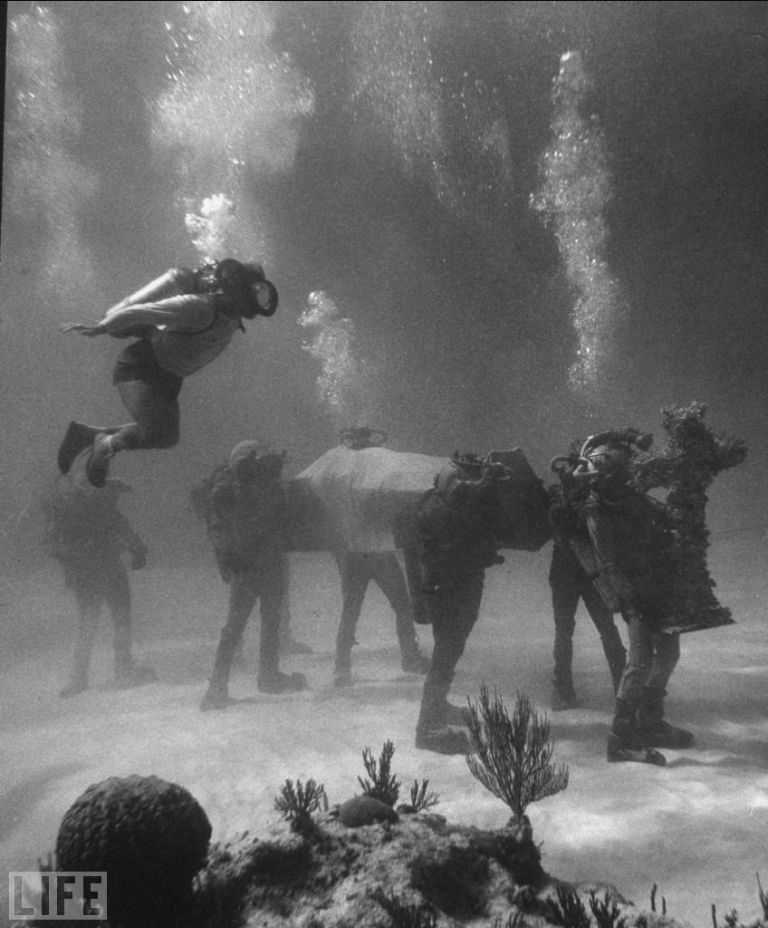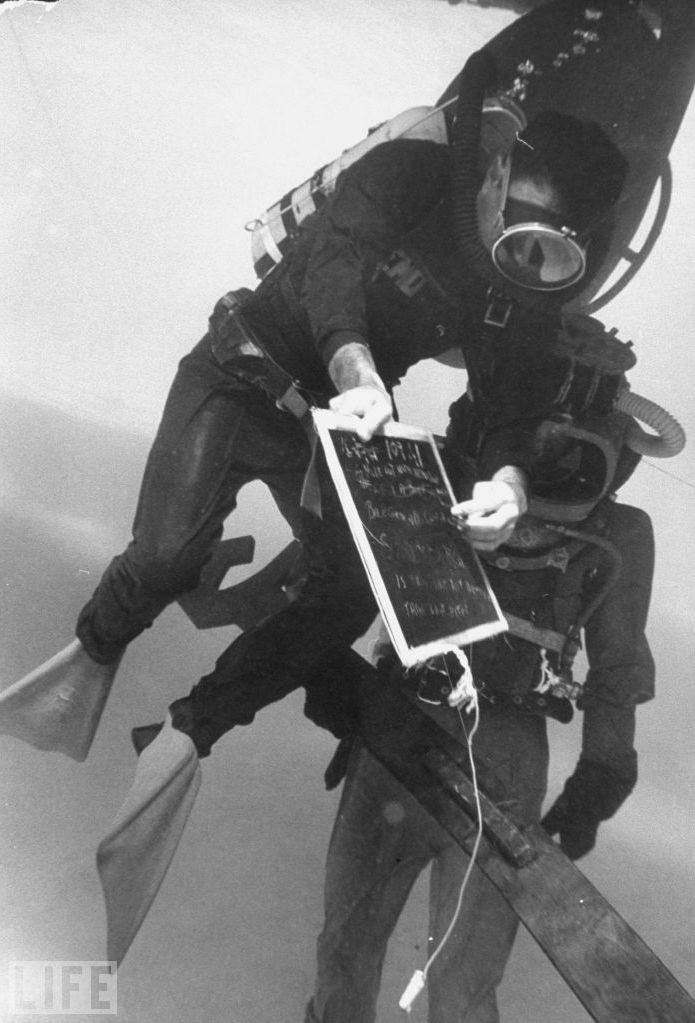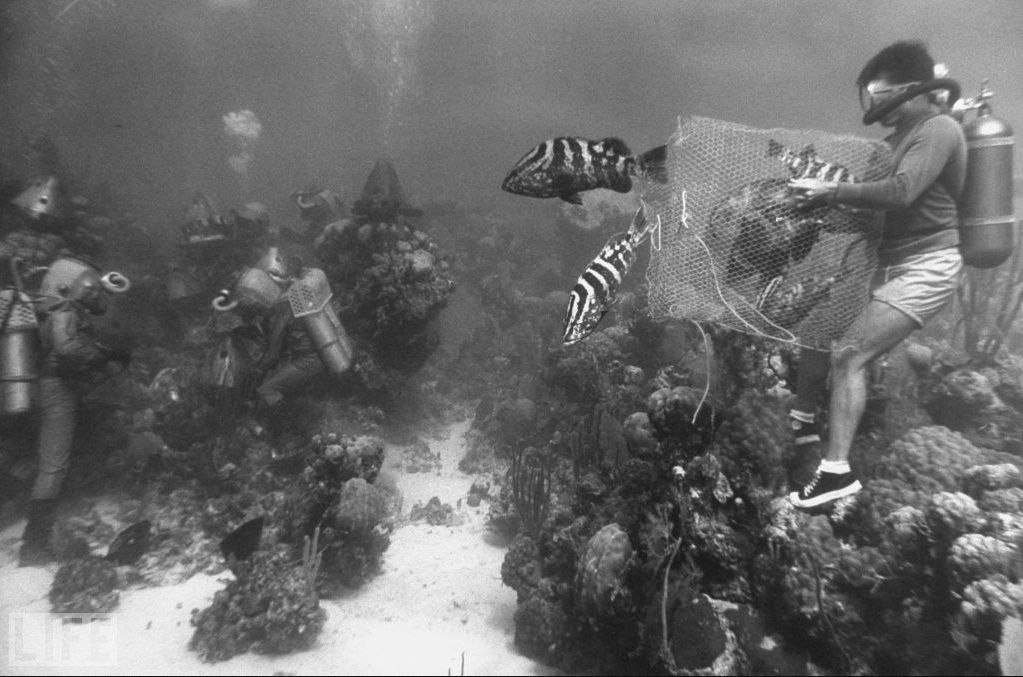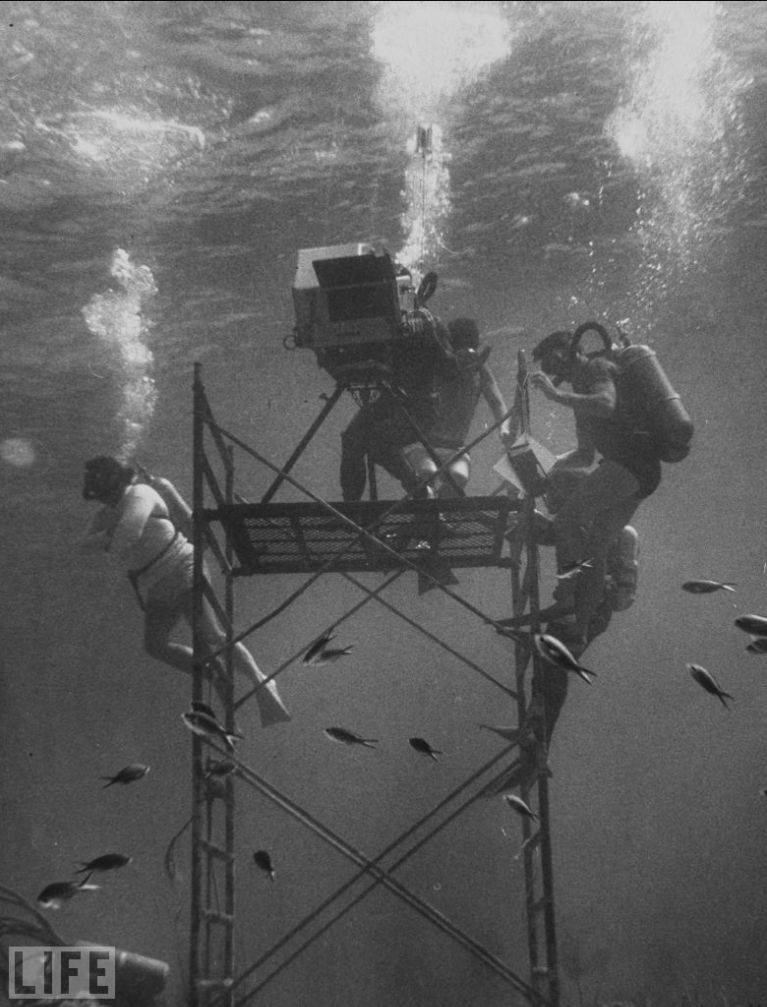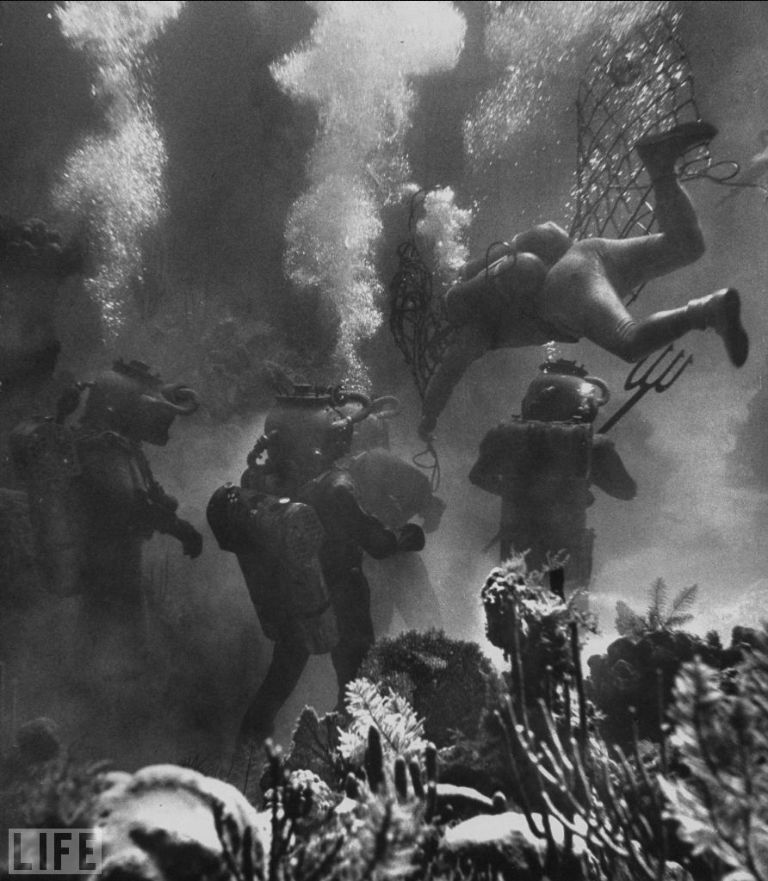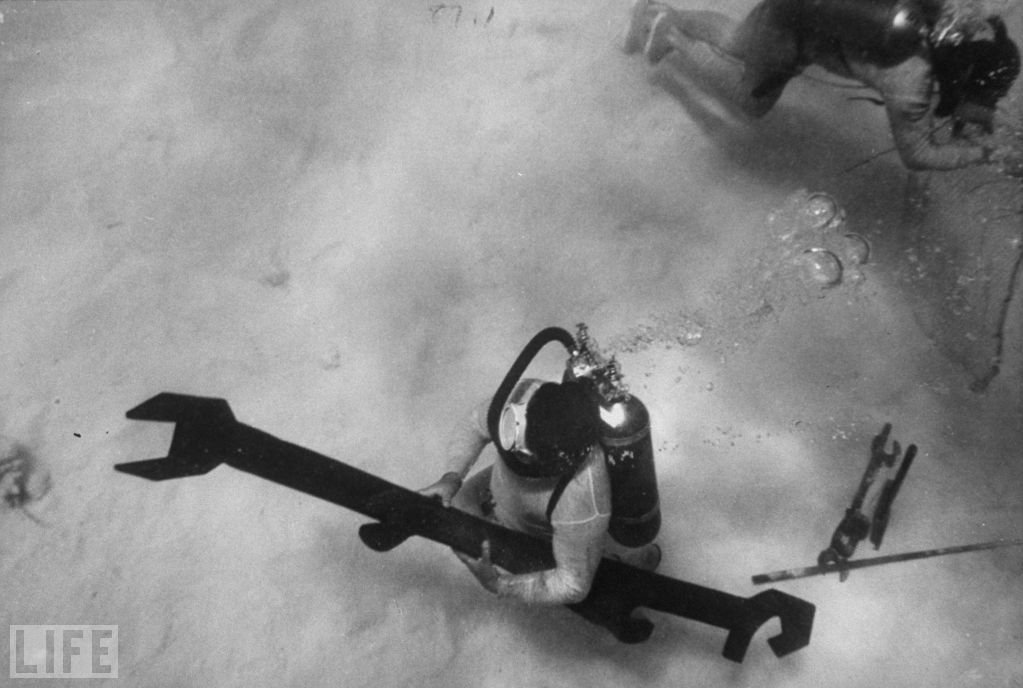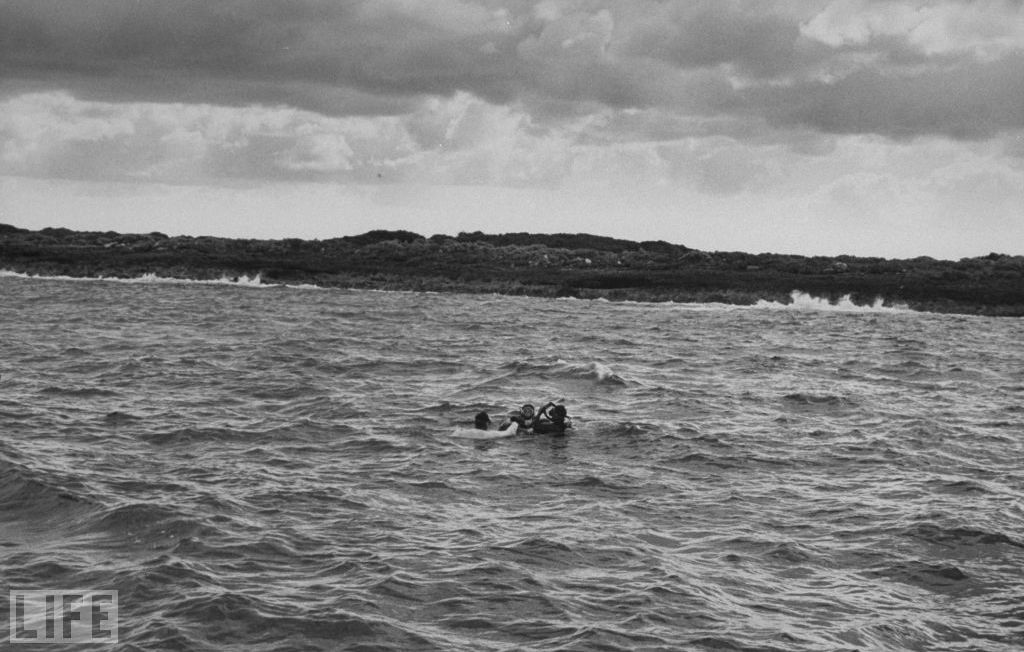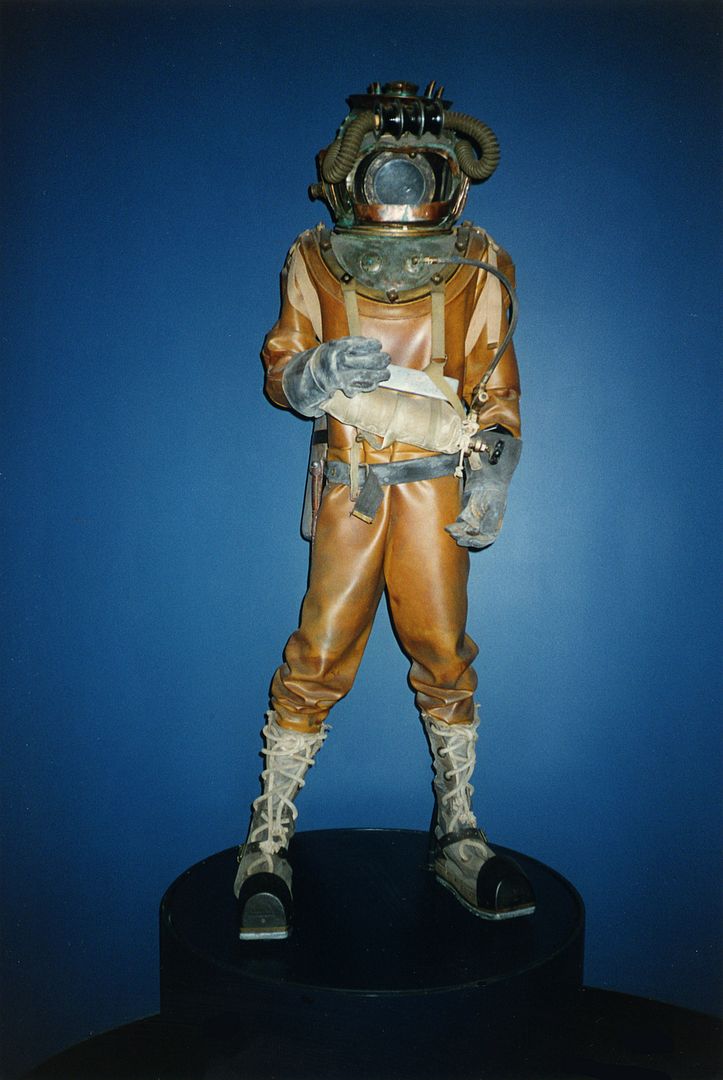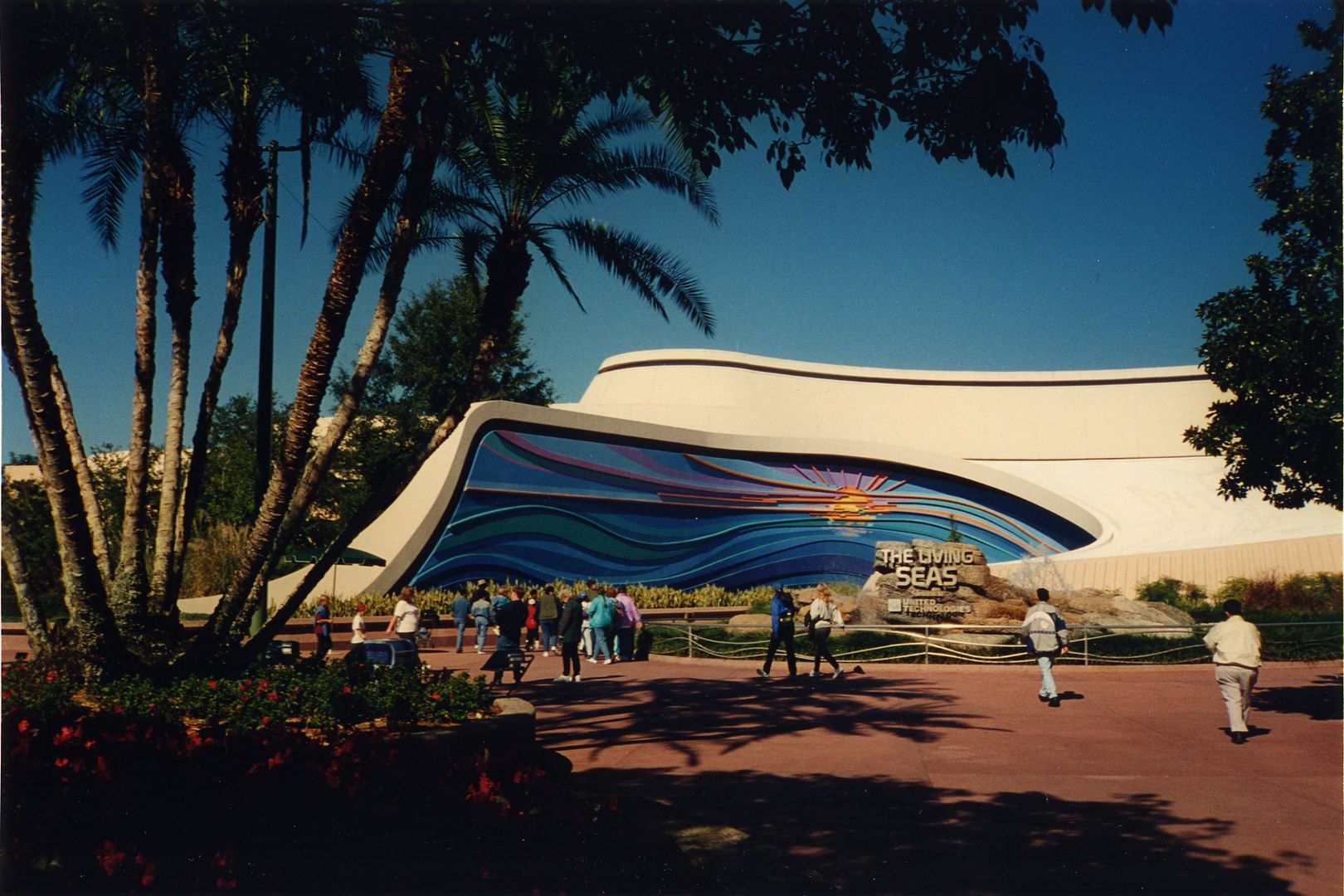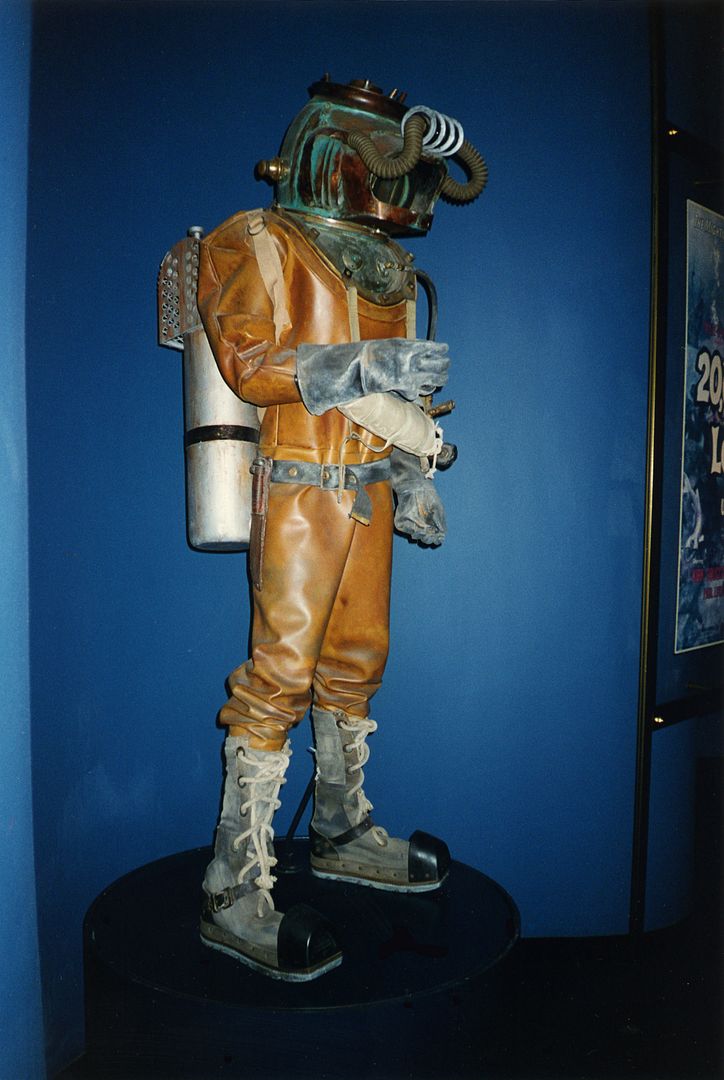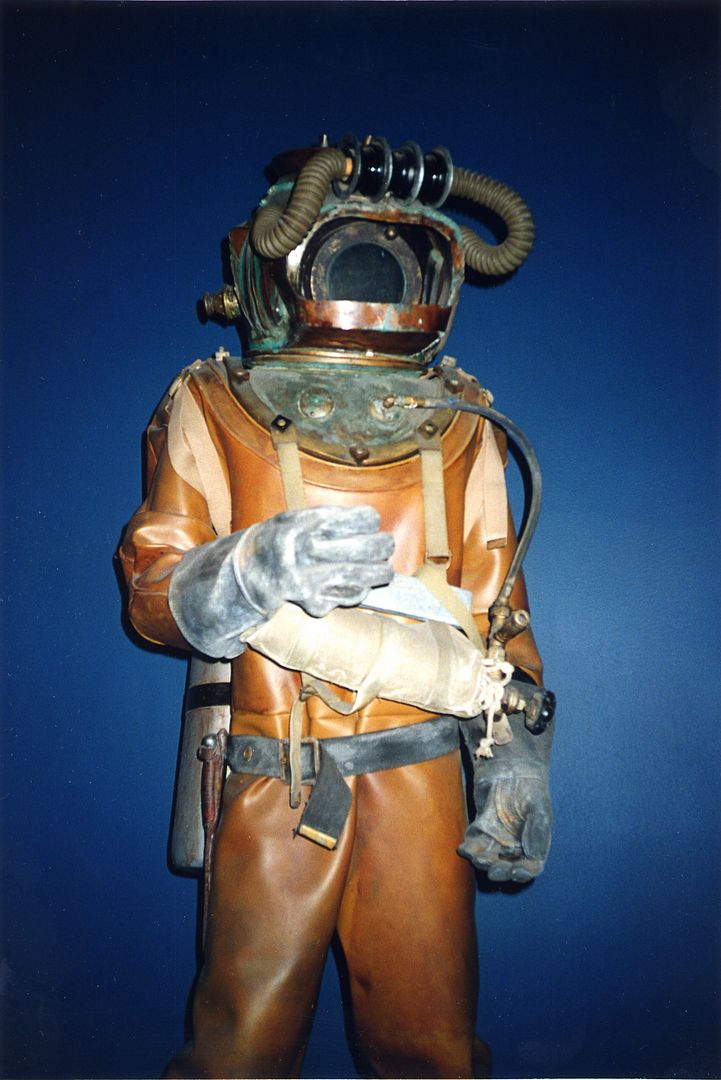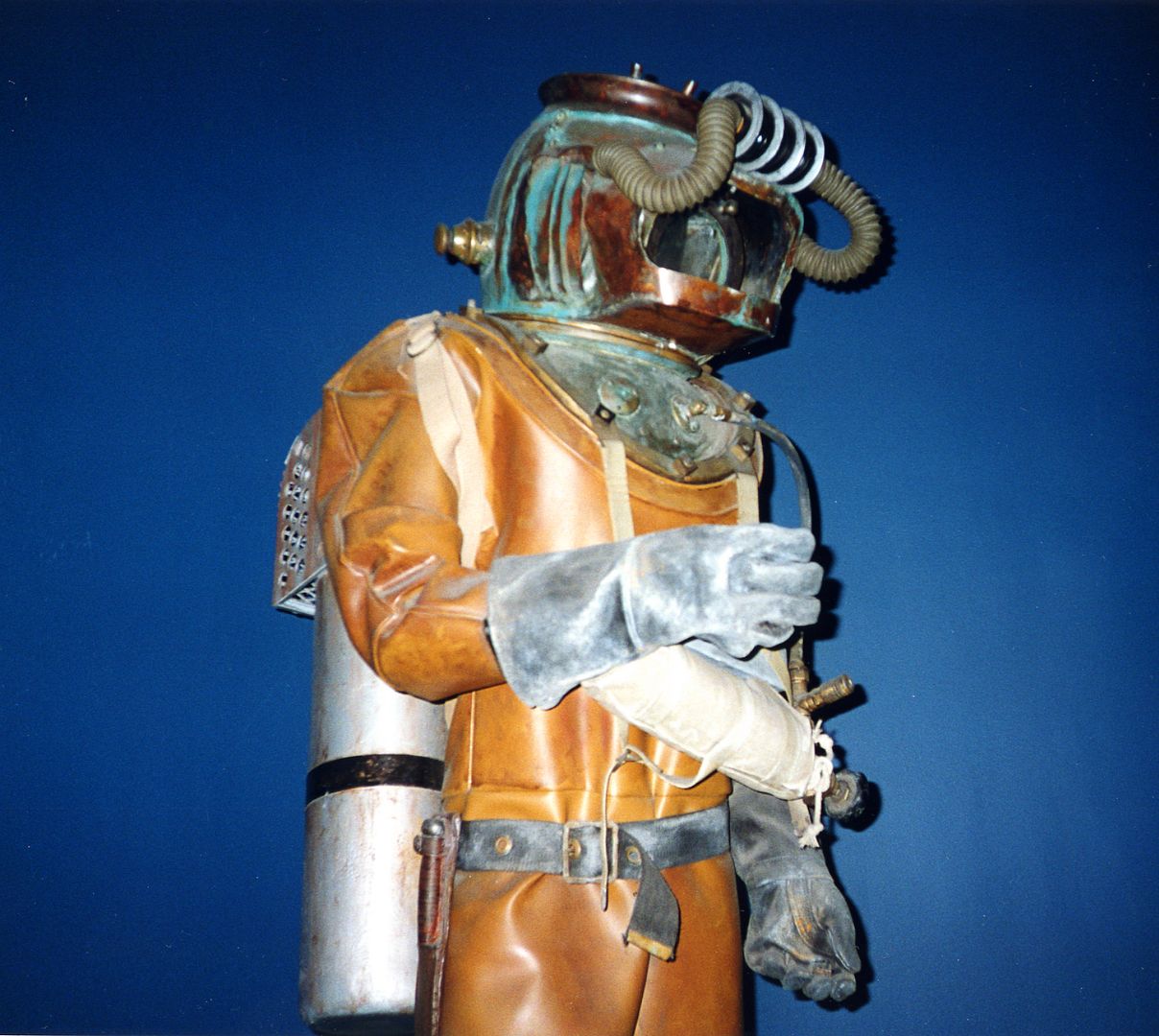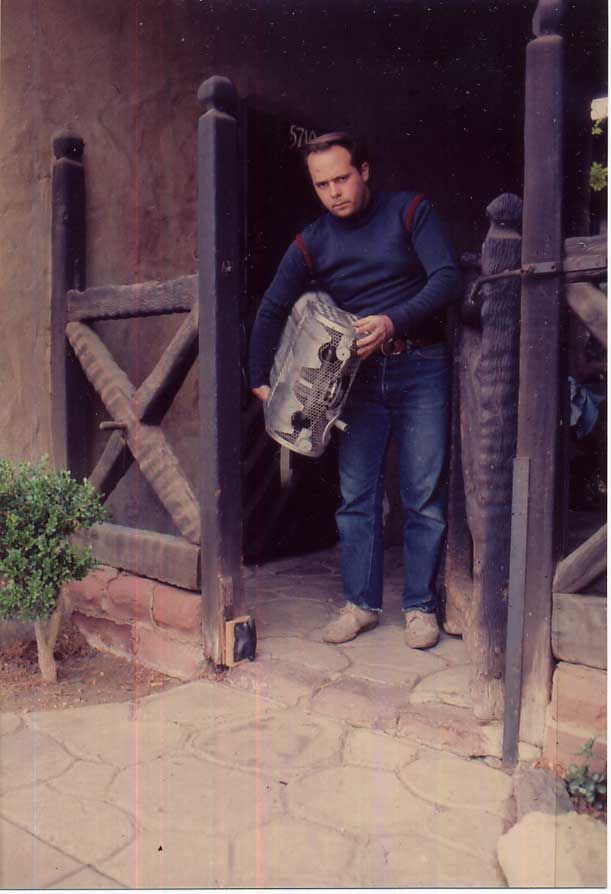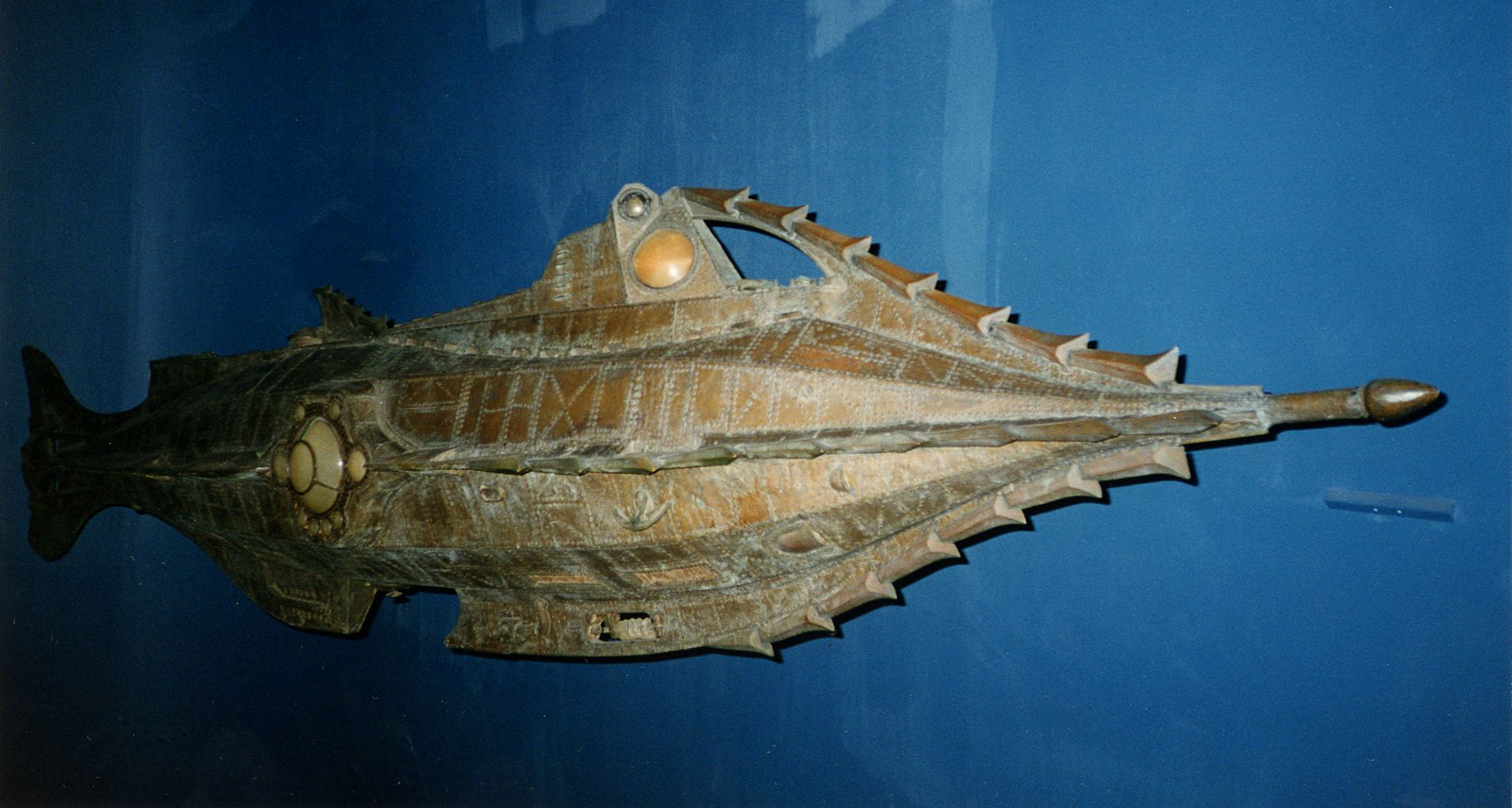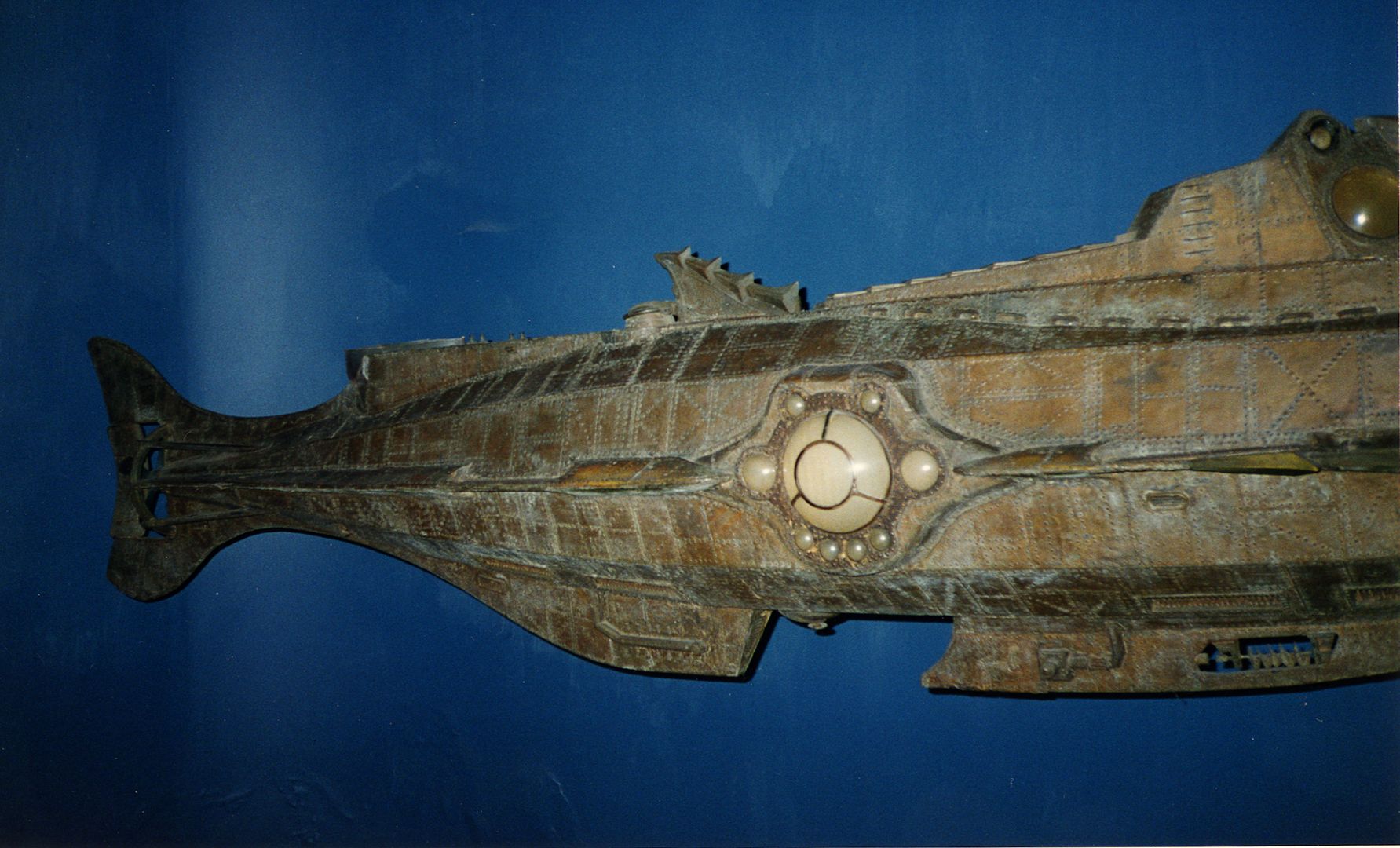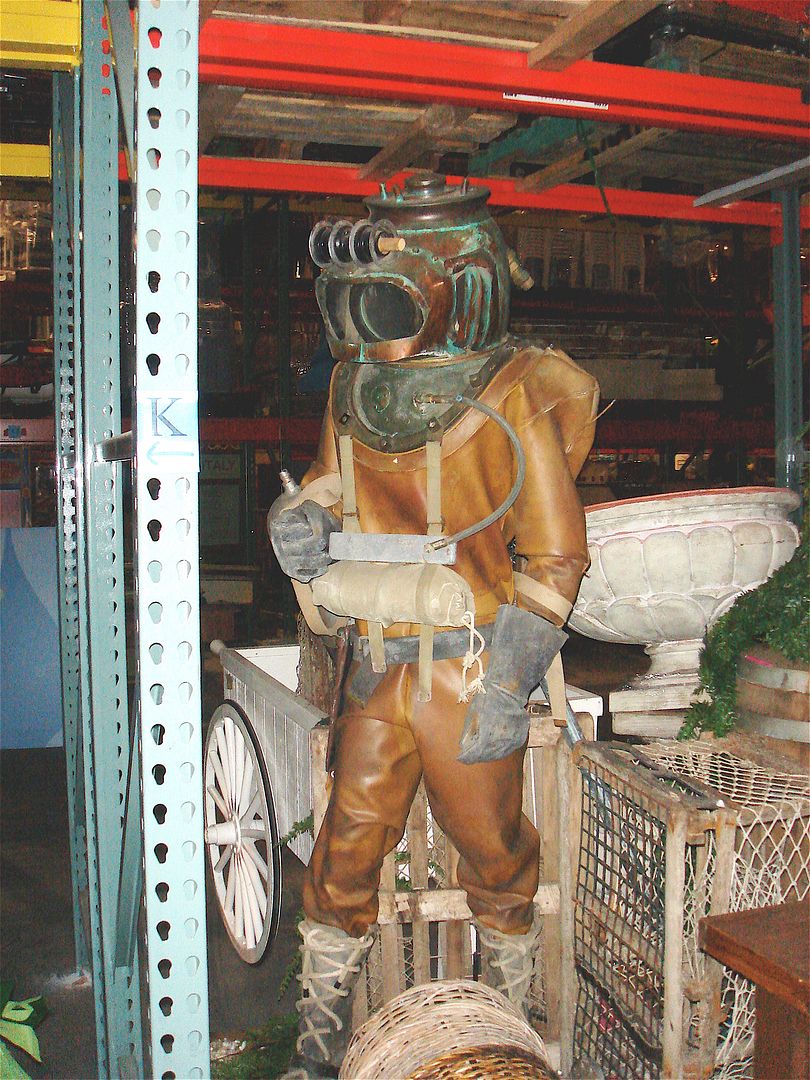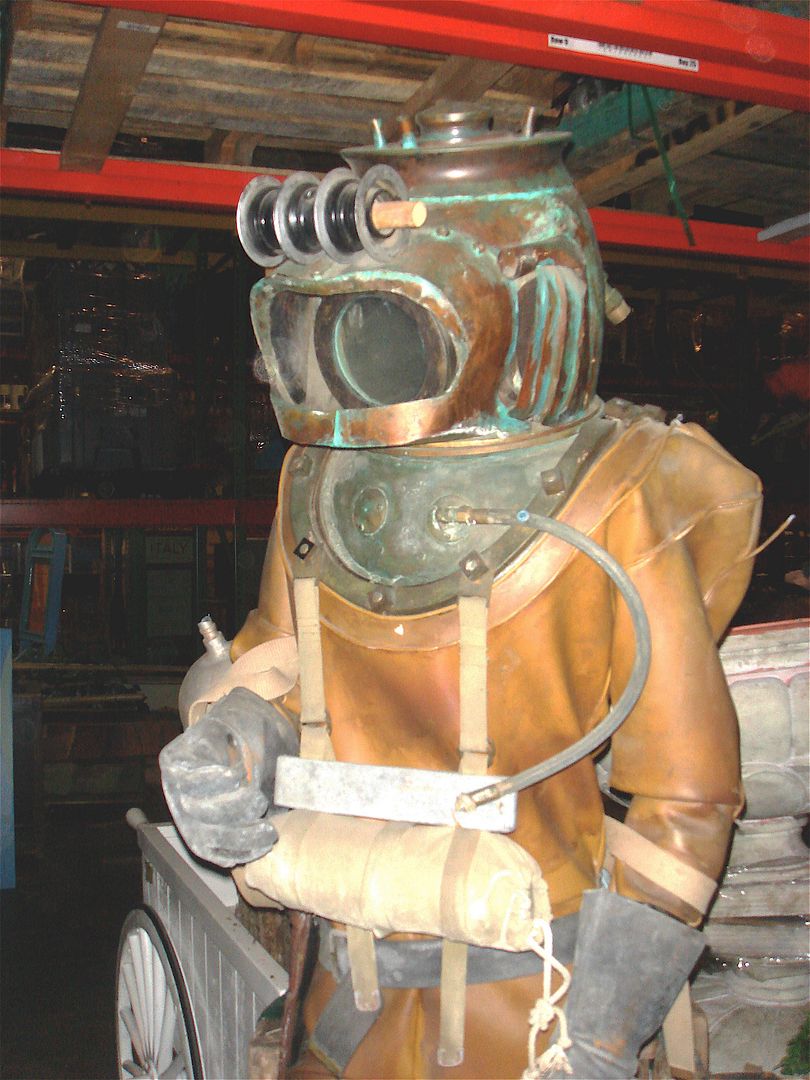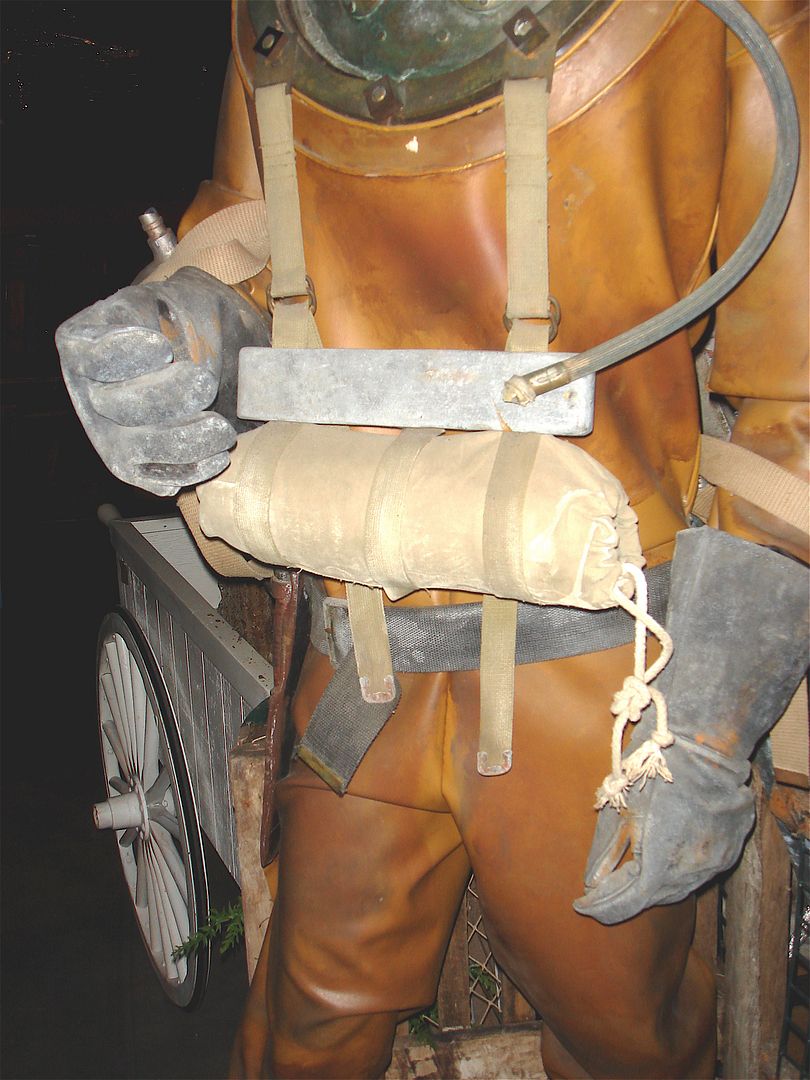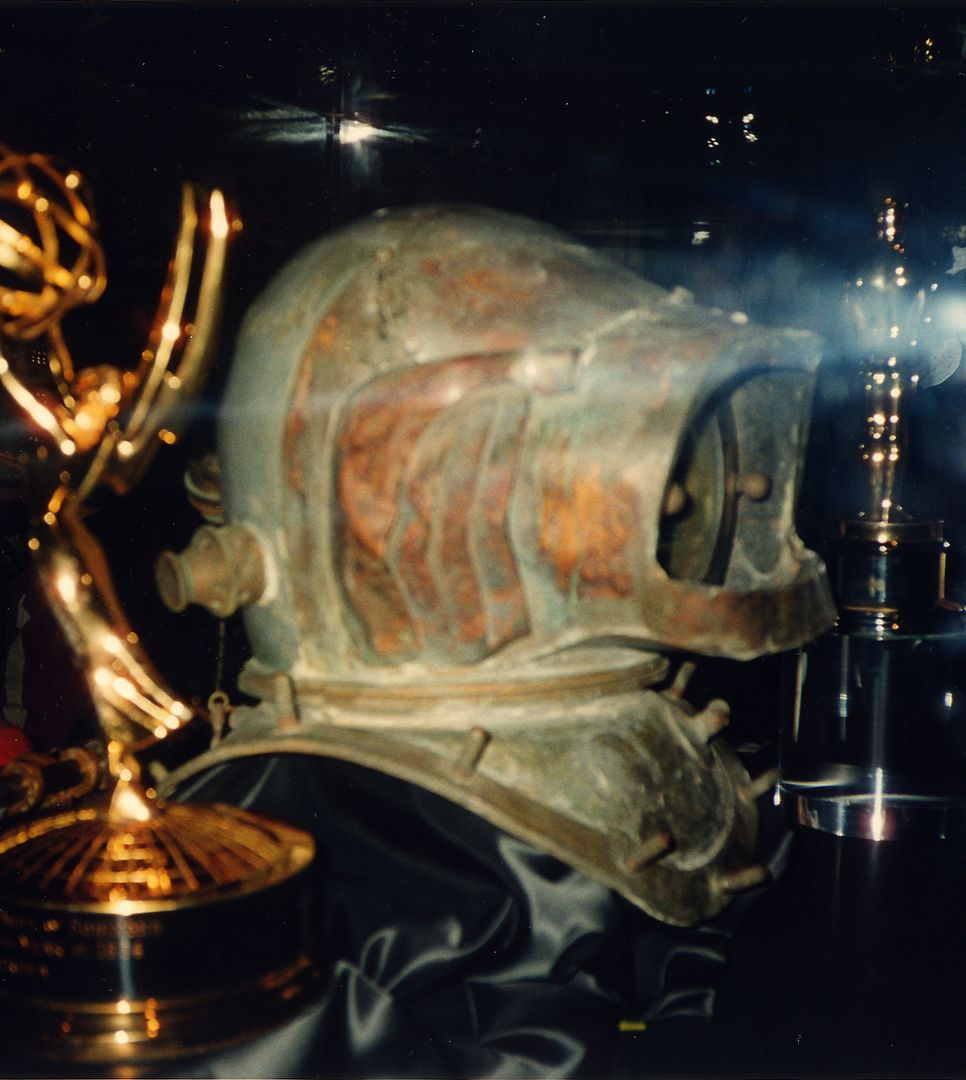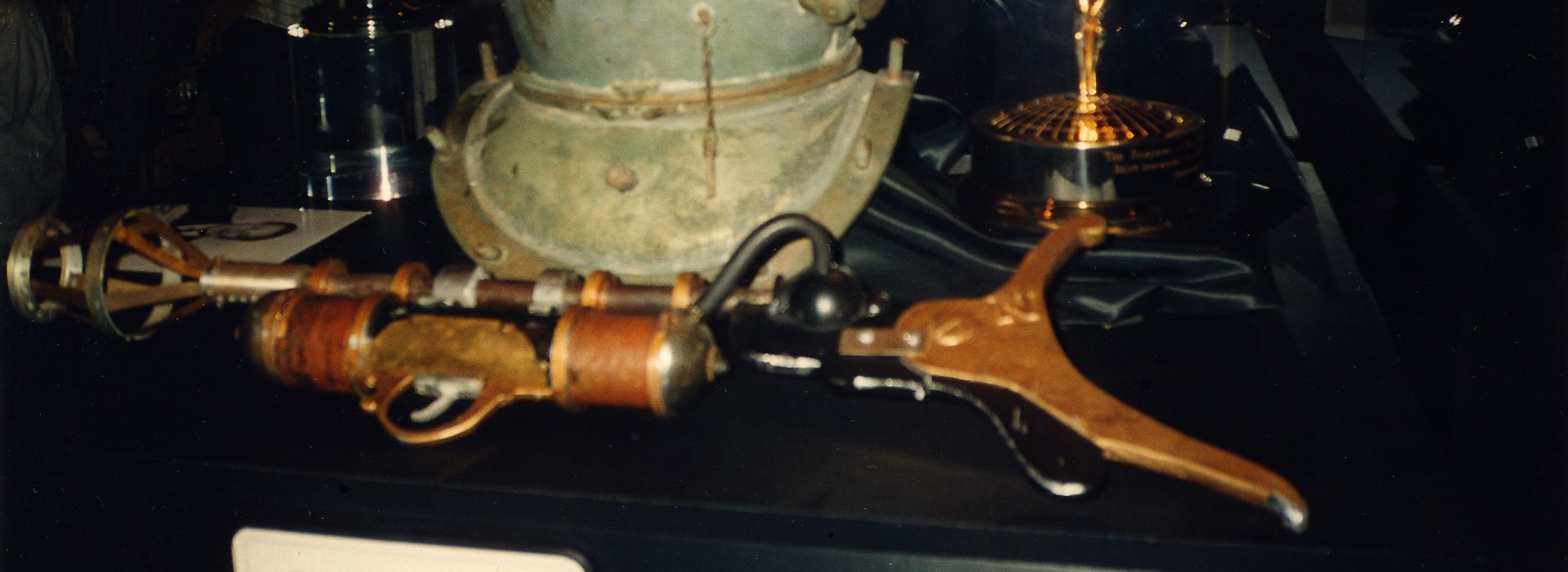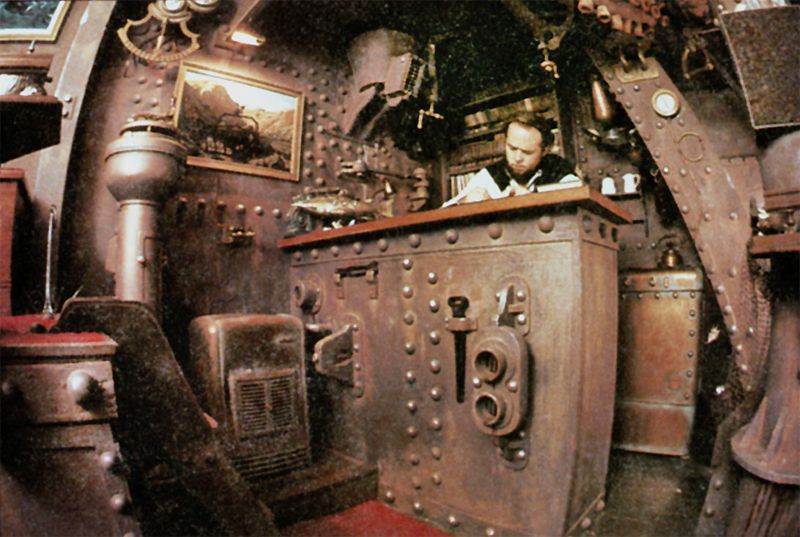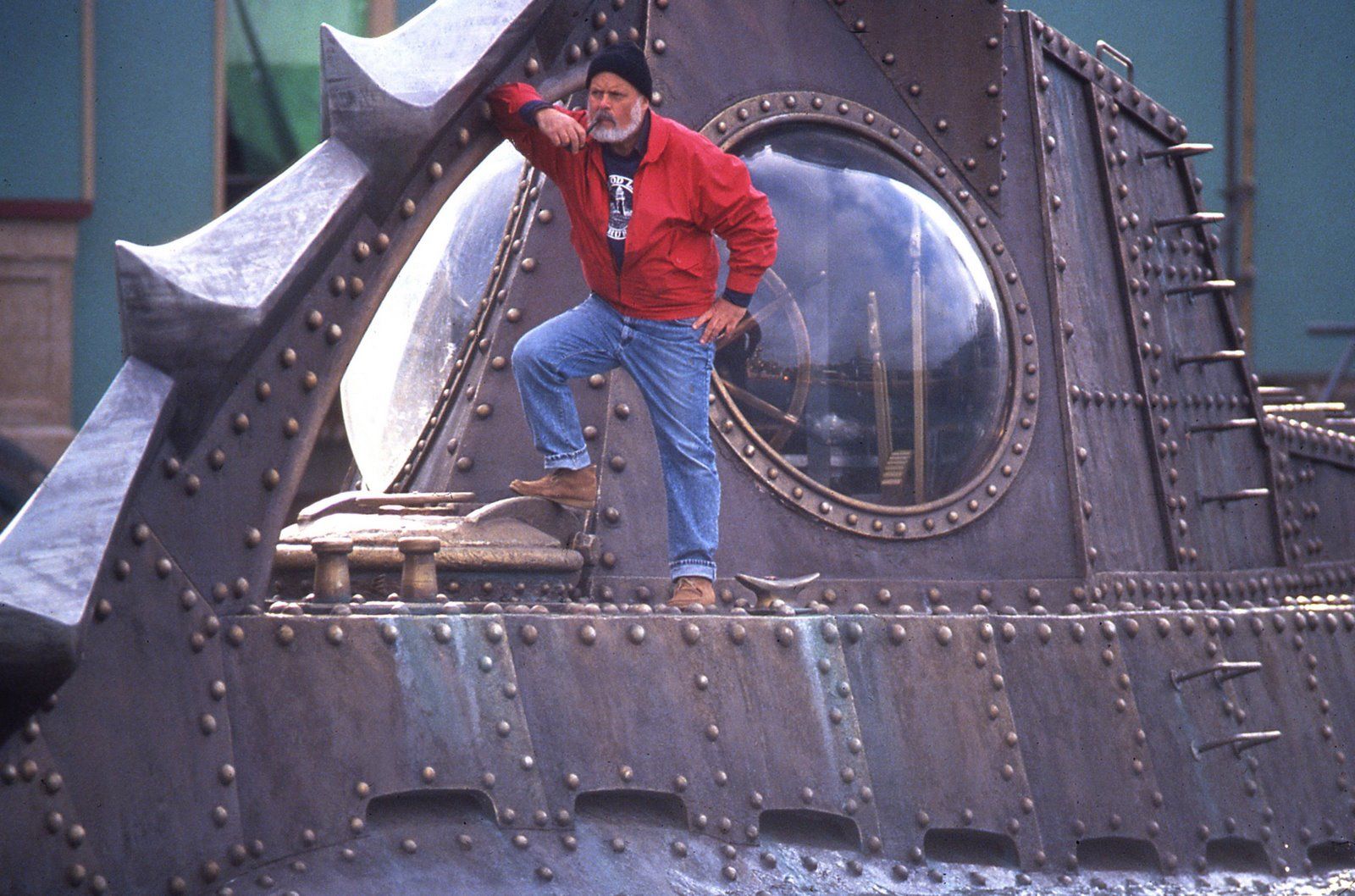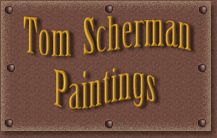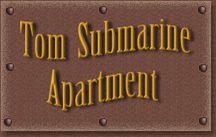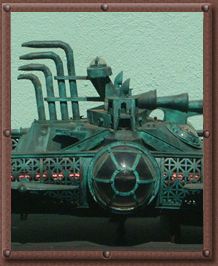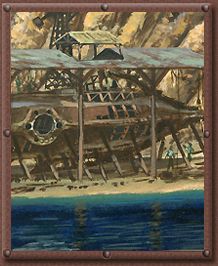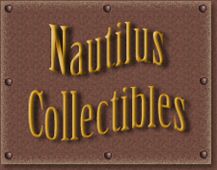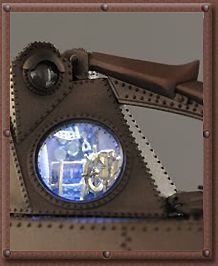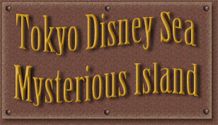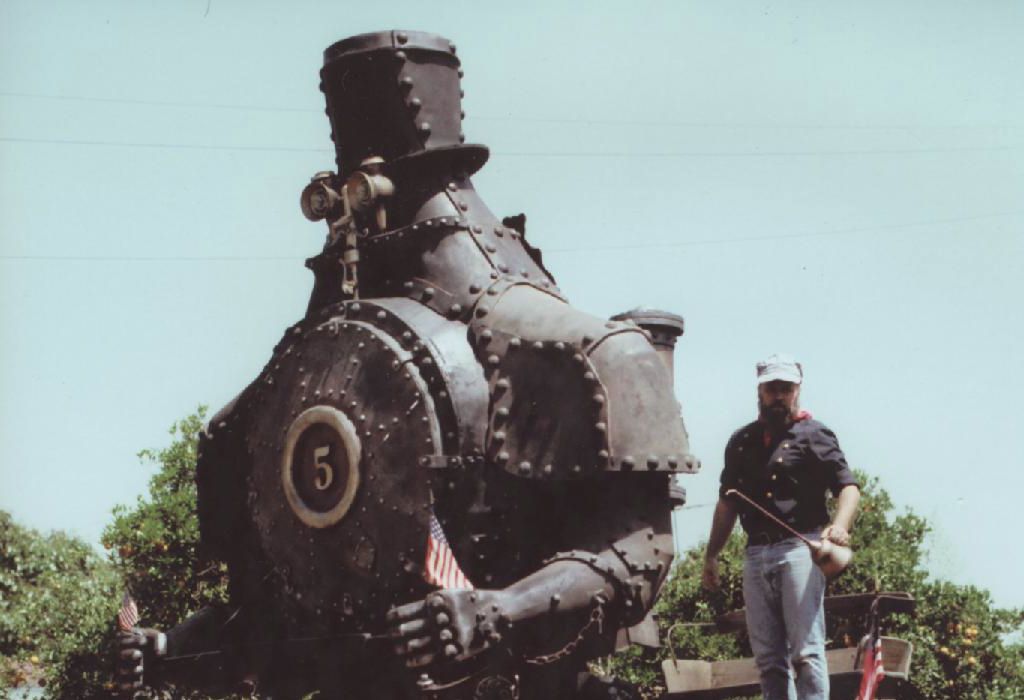
Back in 1983, just after Walt Disney World opened it's new Epcot and World Showcase, we also got Tokyo Disneyland completed and we were going successfully. Work at Imagineering was again in a slow period, so in 1984 as WED became WDI, Ward Kimball and Tom Sherman talked about some way to introduce Tom's steam powered Iron Man in a movie pilot. Tom's Iron Man was inspired by Jules Verne and was designed as if it was created by Captain Nemo of the Nautilus, to help with his work on Vulcania Island. The Iron Man could also pull additional wagons of supplies for the Nautilus.
Picture on top: A close up of the Iron Man's creator and legendary Nautilus expert having created them at both Paris Disneyland and Tokyo Disney Seas, is Tom Sherman. His attention to detail is just as fine on this creation with all its riveted plating and reinforcements. Even the smoke stack is fashioned like a period top hat with rivets and brim. The eyes are constructed of 2 coach lamps to give vision at night while traveling or doing stationary work. The nose and mouth are made of a steam whistle to give voice and command to the Iron Man. His steam cyclinders placed on the back are much like Nemo's air tanks placed on his divers. The stomach is one big boiler with it's riveted inspection plate and cast No.5. Does this mean there may be 4 others before him back at Vulcania Island?Tom had previously developed a TV pilot for the Nautilus and Captain Nemo, that he showed to a few of us at WED in about 1978. He had hoped to make a Saturday weekly TV 1 hour show for kids and Nautilus fans of which he had many. Tom hoped Tony Baxter could show his pilot to then Disney President Ron Miller, as Tom felt Disney should do the show. I don't know what happened with that connection, but then it may pop up again as ideas are never lost at WDI.
Tom had borrowed a bunch of Harper Goff's original Nautilus drawings and sketches, and went to Japan to do some lectures on the subject. I met him in Tokyo at that time and he showed me his own new mechanical wonders like the "Journey to the Center of the Earth" burrowing machine and others including the Nautilus, which eventually became later a part of Tokyo Disney Seas. I also saw Tom's "Burrowing" machine show up on an album cover in Japan and told him about it. I was interested in the sketches of Tom's Steam Powered Iron Man that was of the same period as the Nautilus. He remembered that and gave me a call in about 1985, and asked if I would be interested in helping him stage his steam powered Iron man in a Race at Ward Kimball's "Grizzly Flats" with his coal burning steam locomotive Emma Nevada. I thought that sounded great as I had never been to Ward's and would love to take it all in. Ward's contributions to The World Of Motion pavilion were a big favorite of mine.
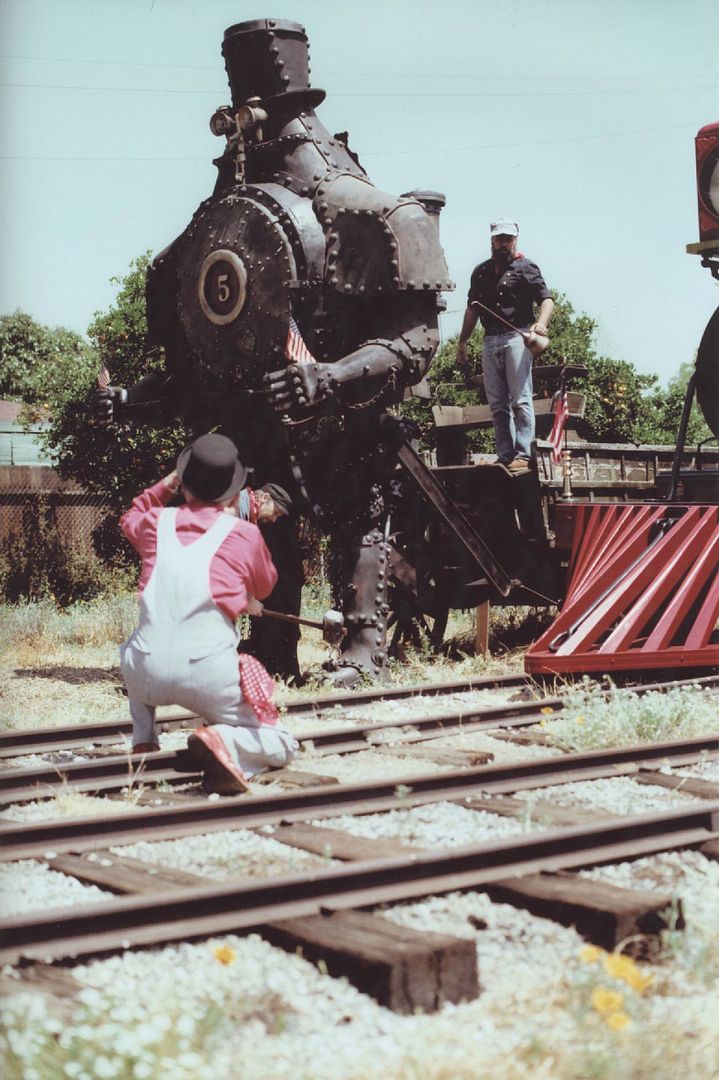 Above: This was one of my favorite moments of the day as I captured Ward Kimball in his bowler capturing Tom Sherman with his creation Iron Man No.5.
Above: This was one of my favorite moments of the day as I captured Ward Kimball in his bowler capturing Tom Sherman with his creation Iron Man No.5. Tom arranged to pick me up with his steam powered Iron Man in many pieces in the back. When we arrived at Ward's, he already had a bit of a crowd waiting for the Great Race and even more for his Emma Nevada to come out after many years in a dead calm. He had to get that day a special permit from the city to fire her up with coal. Ward had us drive back to the train barn and there I helped Tom assemble his Iron Man staged to look like it was pulling an old horse drawn wagon. I didn't realized it was so tall, and luckily Tom had created it from Scott Foam with a rubber like Grip glue mixed with asbestos covering the outer surfaces of many riveted plates and fittings in Nautilus tradition. His attention to detail was beyond fantastic with the materials he was using.
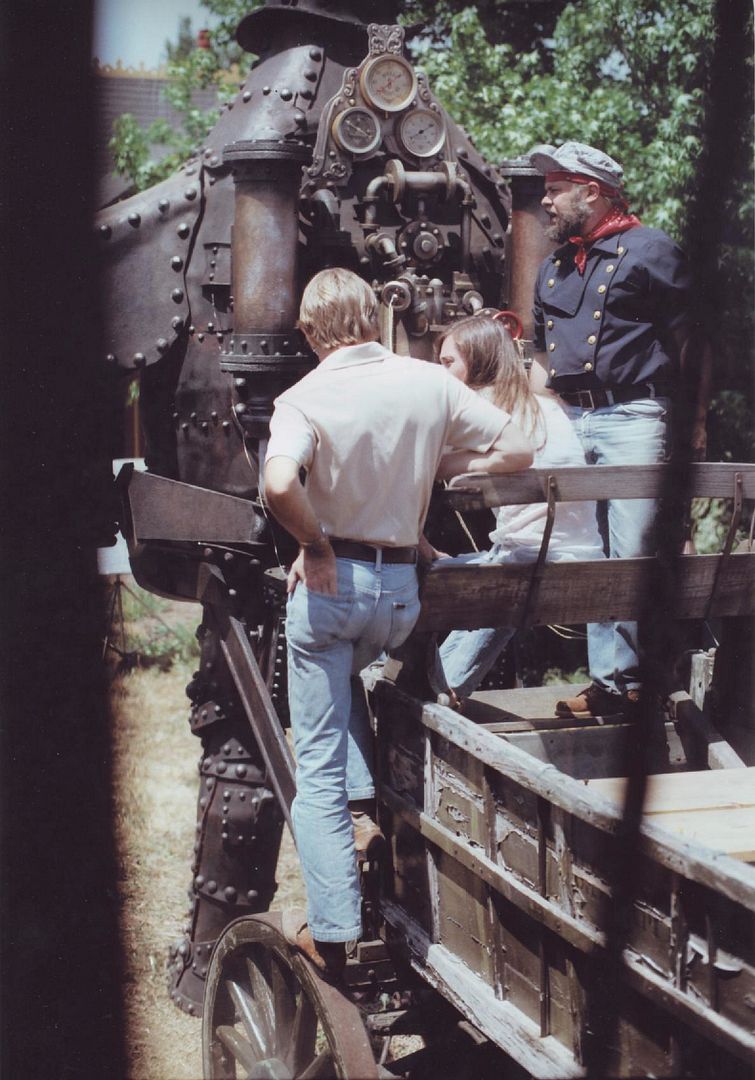 Above: Engineer Tom Sherman prepares his Iron Man No.5 for the Great Race as fans look on. All of the steam powered controls and cylinders are mounted on the back side as he makes final adjustments. Tom's attention to detail with the cluster of steam gauges reflects his talents with the Nautilus at Disneyland Paris.
Above: Engineer Tom Sherman prepares his Iron Man No.5 for the Great Race as fans look on. All of the steam powered controls and cylinders are mounted on the back side as he makes final adjustments. Tom's attention to detail with the cluster of steam gauges reflects his talents with the Nautilus at Disneyland Paris. As you look at Tom Sherman's Iron Man, on the top of his head is a "stovepipe top hat" as they were called in Lincoln's day and worn by other people of stature in the middle of the 18th century. While the Iron Man is a non functional concept creation by Tom, it is the center of all this celebration captured here. The Iron Man unlike the trains does not need rails to travel on. Much like a steam powered Case, Russell, or Minneapolis Traction Engine it can go where trains can't. Tom's Iron Man does have to be hooked up to a wagon which would house the power supply as a tender to a locomotive with wood and water to run the steam power. Pictured is a wood wagon which Ward Kimball had handy for this shoot, but in reality it would be steel wheeled and constructed much like those behind the 22 foot Minneapolis traction Engine that I purchased for DLP's "Thunder Mesa" in 1992.
The Iron Man's legs would move back and forth in a 4 mph top speed in a forward or reverse movement much like the speed of the Minneapolis. The smoke would exit out of the top of the hat on his head. The arms would have been used to pull it's power supply wagon of coal and water as pictured, or to carry tools that it could operate like a burrowing apparatus or do heavy lifting of steel for construction. The Iron man's operator would sit just behind him in the wagon seat. From there he could stand when needed to operate all the controls on the back side or refuel the boiler. On the front, just like Ward Kimball's No.1 and No. 2 locomotives, is a boiler clean out door with Iron Man's No.5 number plate.
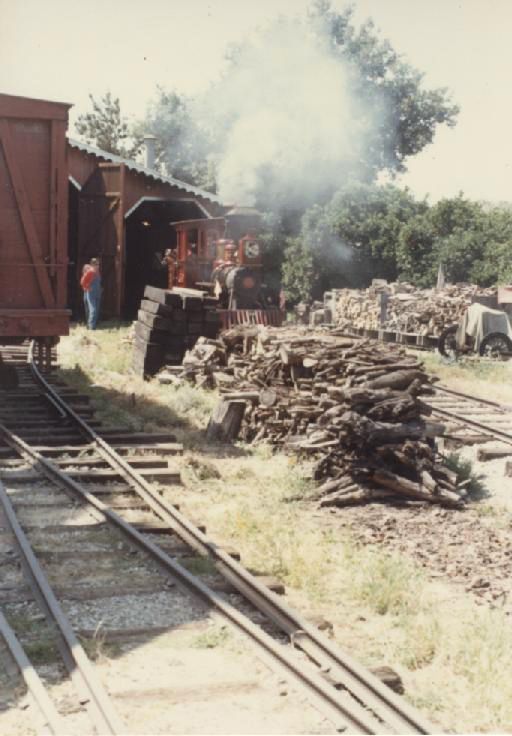 Above: The Chloe is being brought out of the carriage barn for a fuel stop by the wood pile before pulling up to the starting line.
Above: The Chloe is being brought out of the carriage barn for a fuel stop by the wood pile before pulling up to the starting line.
Chloe is Ward and Betty's 1917 Baldwin 0.4.2 RT Sugar Plantation locomotive No.1, which was named after their daughter Chloe. She arrived at Grizzly Flat's around 1948, which was just before the train depot was errected. As the "Emma Nevada" went out of service the "Chloe" came into service in 1956. The "Emma Nevada" came down with some mechanical problems combined with neighbors negative reactions to her coal smoke and cynders. The "Chloe" ran on wood and was less of a topic of debate. I'm sure we have all tasted that before. On this special day, Ward's daughter Chloe told me she had been at Walt Disney World during much of its original construction before it opened in 1971. Her son Nathan Lord also operated the locomotive with her brother John Kimball at "Grizzly Flats" and were present for this event. 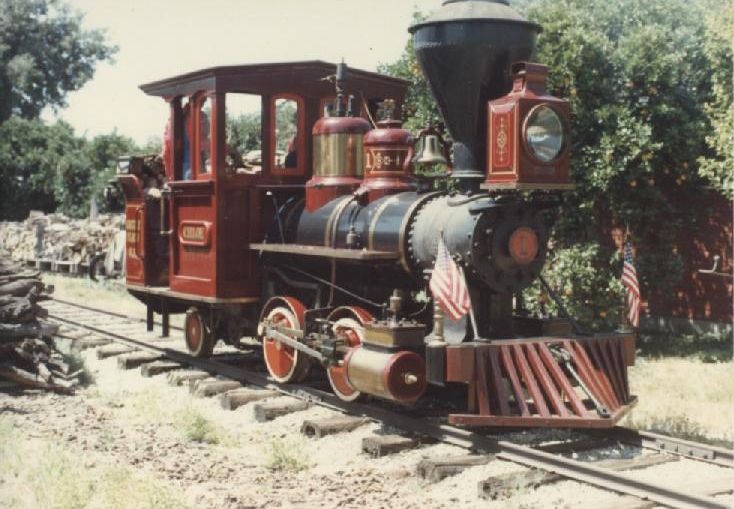
Above: The Chloe team taking a break back in the cab after refueling. 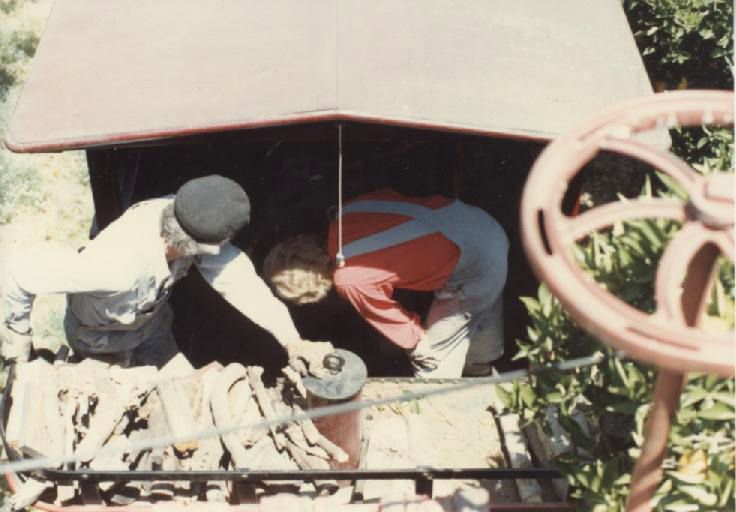 Above: Engineer John Kimball and team building up some steam in the Chloe, as I take a shot from the Brakeman's position just behind the tender.
Above: Engineer John Kimball and team building up some steam in the Chloe, as I take a shot from the Brakeman's position just behind the tender. 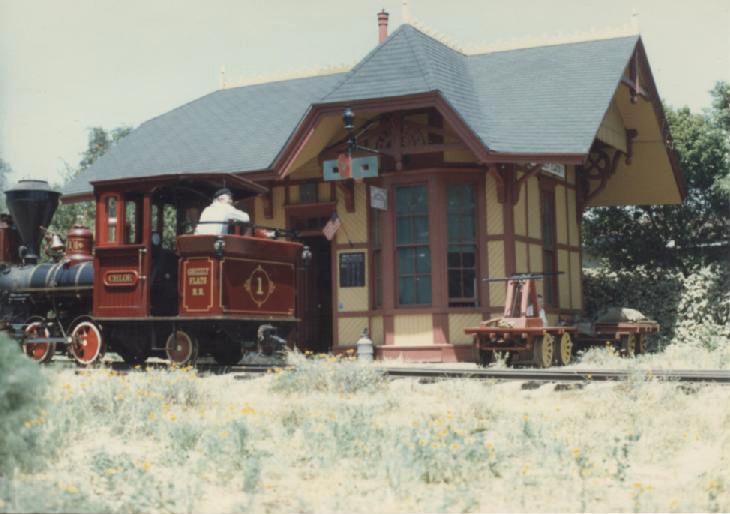
Above: Great shot of the Chloe and "So Dear to My Heart" station, along with 2 man hand cart and pull car. Ward and John have gone inside station momentarily to reset station signal for the race. John will later demonstrate the art of pumping cart with hands and feet at the same time. I missed that shot as I was so amazed.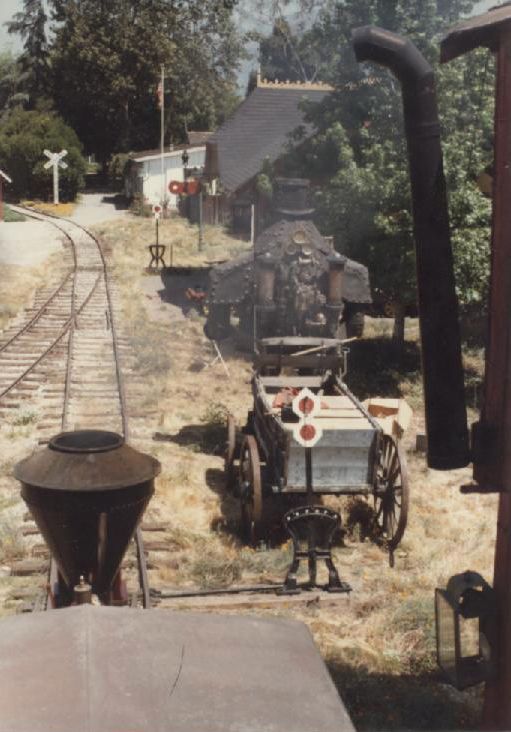 Above: The Emma Nevada is pulling out of the carriage barn as I look down from it's box car in my brakeman position. The Grizzly Flats station is ahead on the right and the long and narrow track is lined with orange trees as Iron Man looks on.
Above: The Emma Nevada is pulling out of the carriage barn as I look down from it's box car in my brakeman position. The Grizzly Flats station is ahead on the right and the long and narrow track is lined with orange trees as Iron Man looks on.
The "Emma Nevada" is Ward and Betty's adopted 1881 Baldwin 'Mogul' 2.6.0 coal burning locomotive. Formerly the "Sidney Dillion", Ward renamed her the "Emma Nevada" engine No.2, after a famouse1800's opera star and she was their pride of "Grizzly Flats". After rebuilding her, he painted her in a theme like other engines of 1870's. The headlight has Ward's figural paint work on it an she is truly a lady. The engine ran from 1942 to 1951 at Grizzly Flat's, so seeing her here on this special day was a great event and I was glad to be the brakeman.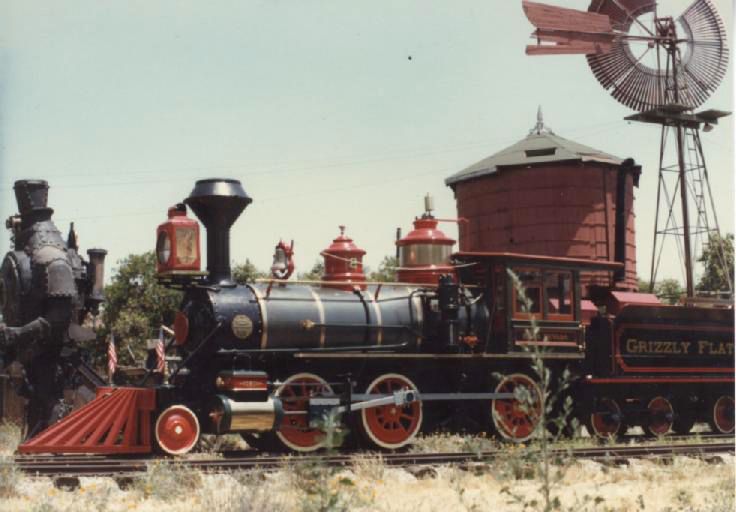 Above: The pride of "Grizzly Flats", the Emma Nevada, is lined up with the Iron man hours before the race commences.
Above: The pride of "Grizzly Flats", the Emma Nevada, is lined up with the Iron man hours before the race commences. 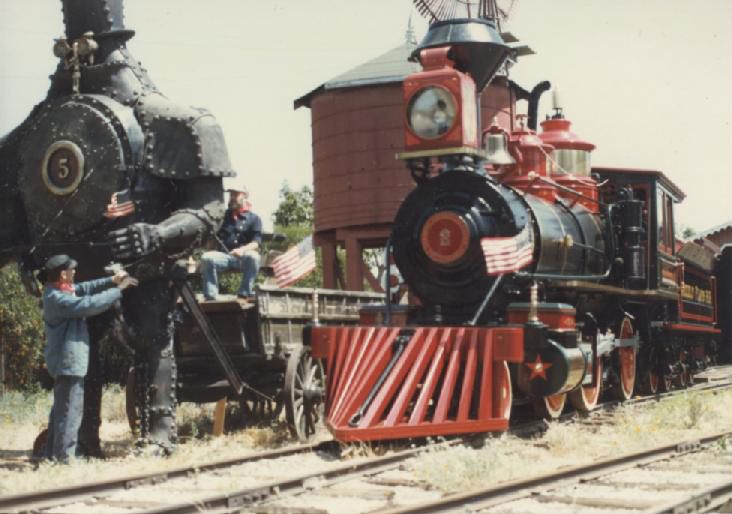 Above: Engineer Tom Sherman and apprentice get an early start making adjustments on the Iron Man, as the Emma Nevada pulls up.
Above: Engineer Tom Sherman and apprentice get an early start making adjustments on the Iron Man, as the Emma Nevada pulls up.As you can see captured in these photos, Tom and friend are really in their element oiling away and making sure the Iron man will be ready for the Race that day. Ward and his family were all involved in the event as well, and made this all possible. Everyone was a winner that day.
After putting on the final top hated head, Tom hooked up lines to a container in the wood wagon, that had dry ice in it that with water induced by a controlled line, would cause smoke to come out of the top hatted chimney stack. Tom got on his engineering outfit complete with giant R.R.oil can and began oiling up his riveted man and adjusting the valves with a friend also seemingly oiling away. Ward got his Emma fired up and checked out while doing his spot oiling, and rolled her up to the starting line even with Tom and his Iron Man. He then fired up his Chloe, named after his daughter, and brought her out and up to the starting line. Ward and his son John were also dressed up in their engineering gear and I was able to document and photograph the "Great Race" start. I got a fun shot just behind Ward, who was on one knee taking Tom's picture. What a great shot of the steam powered man against the steam powered train and all the engineers, with No.1 Chloe standing proud in support.. Never asked Tom how fast his creation could go, but wish I had.
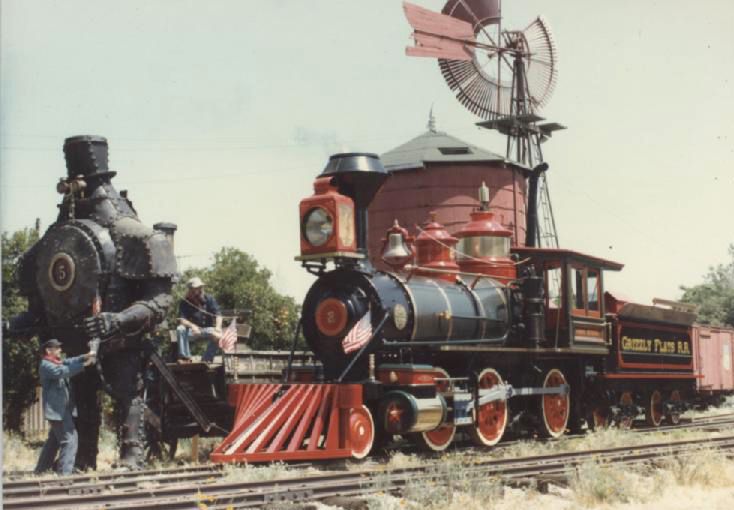 Above: Engineer Tom Sherman taking a moment to inspect his competition , as the Emma Nevada, Pride of Grizzly Flats, is showing a sign of building up steam for the race.
Above: Engineer Tom Sherman taking a moment to inspect his competition , as the Emma Nevada, Pride of Grizzly Flats, is showing a sign of building up steam for the race.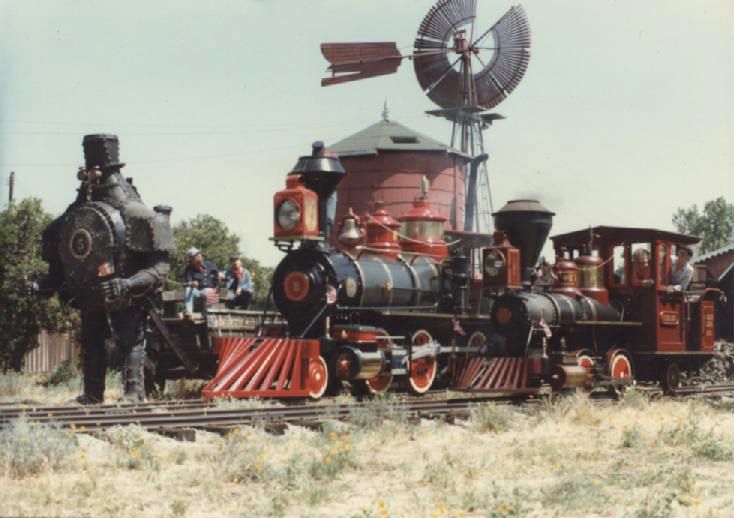 Above: All the Kimball Engineers pull the Chloe up to the starting line and commence with some fine attention before the race begins. The Iron Man and Emma Nevada stand by and ready. Well wishers begin to collect along the trackside.
Above: All the Kimball Engineers pull the Chloe up to the starting line and commence with some fine attention before the race begins. The Iron Man and Emma Nevada stand by and ready. Well wishers begin to collect along the trackside.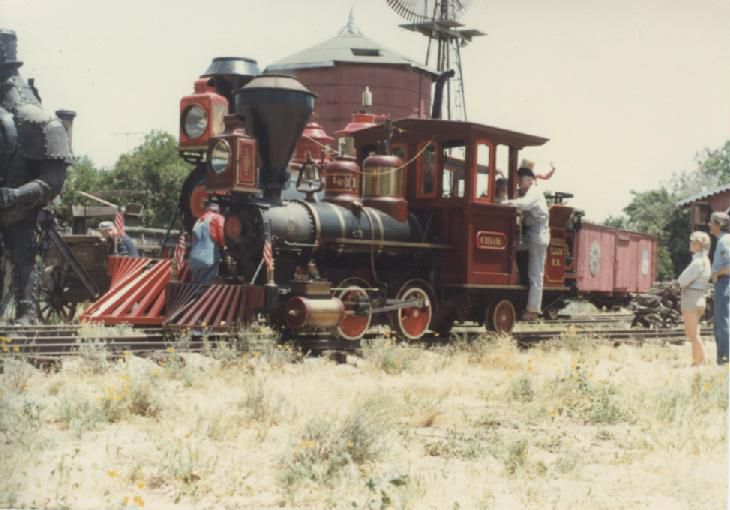 Above: Engineer Tom Sherman is inspecting his wagon connections at the base of his Iron Man. Enginner Ward Kimball is greeting some early well wishers from the Emma Nevada. Engineer John Kimball and his team ready the Chloe with some final inspections and tests.
Above: Engineer Tom Sherman is inspecting his wagon connections at the base of his Iron Man. Enginner Ward Kimball is greeting some early well wishers from the Emma Nevada. Engineer John Kimball and his team ready the Chloe with some final inspections and tests. Ward Kimball asked me if I would like to be his brakeman up on top in case he needed some braking to slow down. It had been over 20 years since the Emma had taken the trip down the straight and narrow through Grizzly Flats and the orange trees which lined the track. Engine No.1, the Chloe named after Wards daughter, had made recent runs as a wood burner, and the trees cleared her fine. Ward and John were in the cab and commenced pulling on the throttle and we started rolling. I had to sit down above them on the box car and hang onto the brake wheel as the orange trees started pelting me and casting oranges all over the place. I looked down into the cab and saw Ward and John just laughing away having a great ole time engaging the Emma Nevada.
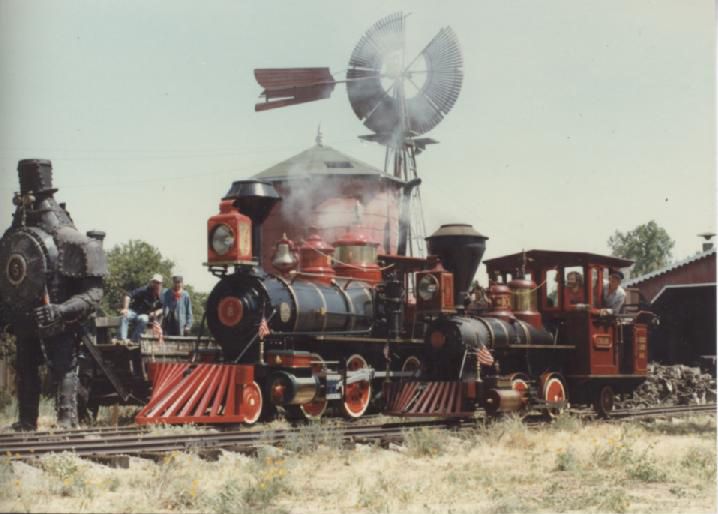 Above: With a full head of steam the Iron Man poses with the Emma Nevada and Chloe at the starting line as Engineers take a final pose. Where is Ward Kimball hiding?
Above: With a full head of steam the Iron Man poses with the Emma Nevada and Chloe at the starting line as Engineers take a final pose. Where is Ward Kimball hiding?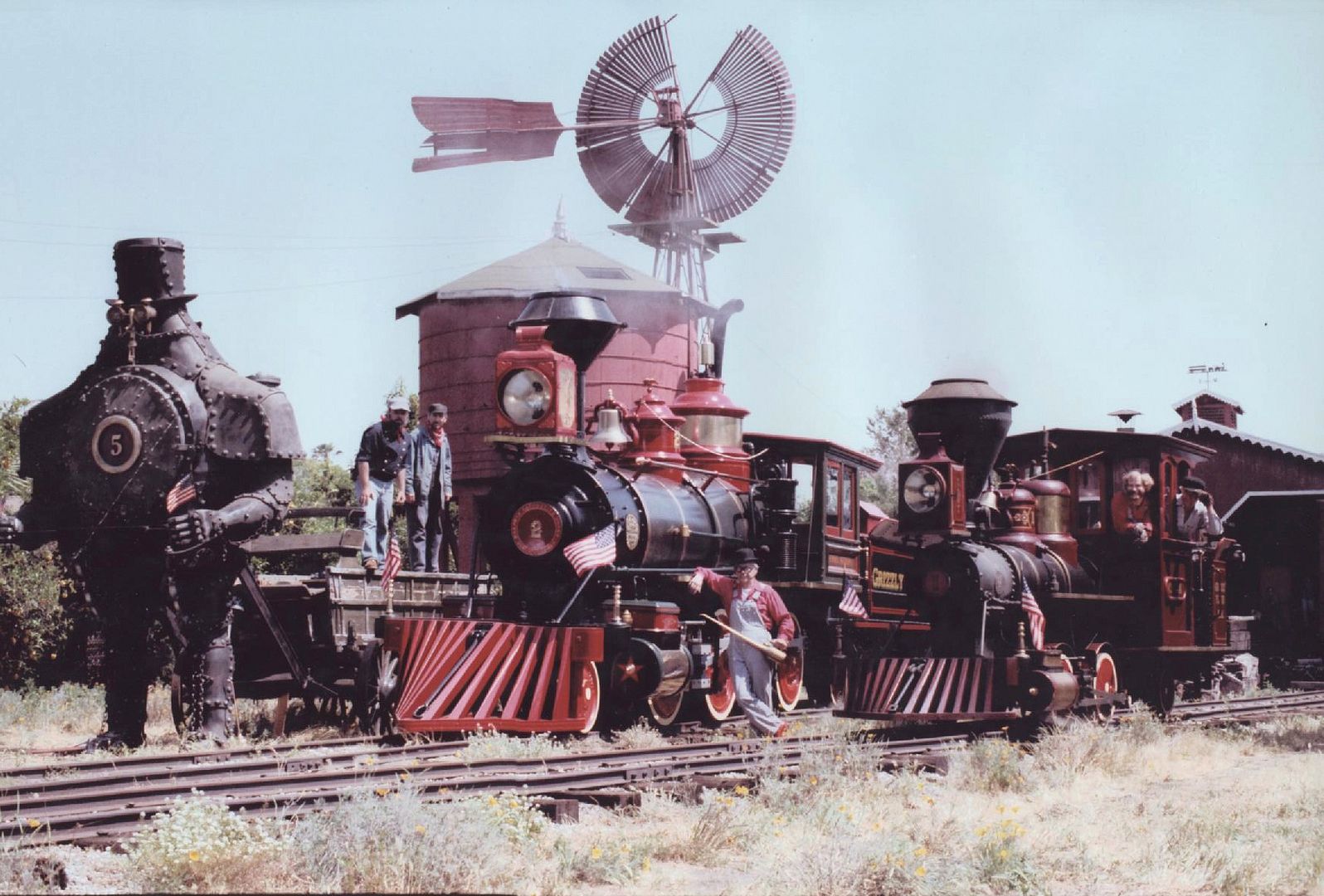 Above: The race is about to start. Engineer Tom Sherman and his apprentice ready Iron man No.5. Veteran Engineer Legend Ward Kimball with his Emma Nevada No.2. Wards son and fellow Engineer John Kimball looks out the cab on the Chloe No.1. (click on this great picture to see it in larger scale)
Above: The race is about to start. Engineer Tom Sherman and his apprentice ready Iron man No.5. Veteran Engineer Legend Ward Kimball with his Emma Nevada No.2. Wards son and fellow Engineer John Kimball looks out the cab on the Chloe No.1. (click on this great picture to see it in larger scale)As we approached the end of the track he shouted and signaled to me to put on the brake which just spun as I turned the wheel and I got worried if we would stop. I learned later that he had air brakes and my job was honorary on the Emma Nevada. Glad I had my camera to record it all. What a Great Day that was, Tom and Ward were in one of their finest moments!
More on Ward Kimball's "Grizzly Flats" train depot:
"Grizzly Flats" originated back around 1938 when Ward and Betty Kimball had layed down a section of track in the middle of their orange trees for their 1881 Coach and new arrival the steam locomotive"Sidney Dillion", soon to be renamed the "Emma Nevada". As their establishment began to grow, they proclaimed it the "Scenic Wonder of the West".
 Above: Close up of Ward Kimball's great architectural detail given to the 1948 Disney movie "So Dear To My Heart" train depot now gracing Grizzly Flats. It was later copied for the Disneyland Fronteirland train depot, and used as a model for Paris Disneyland's "Thunder Mesa Station".
Above: Close up of Ward Kimball's great architectural detail given to the 1948 Disney movie "So Dear To My Heart" train depot now gracing Grizzly Flats. It was later copied for the Disneyland Fronteirland train depot, and used as a model for Paris Disneyland's "Thunder Mesa Station". Where did the train station come from?
Back around 1948, Walt Disney had Ward draw up a train station for his movie "So Dear to My Heart" which the studio was making. As it was just a set, Ward had only drawn 3 sides to the station along with a great roofline. It was based upon a Lehigh Valley Railroad flag depot at Pottsville New York. After the filming was completed and Walt and Ward attended the Chicago Railroad Fair, Walt in a good mood, decided to surprise Ward and had the studio break down the building and truck it over to Ward's "Grizzly Flats". Ward was surprised and commenced with laying down a foundation slab for it. All in pieces and even having drawn it, Ward found it a puzzle. When craning the roof down the walls collapsed and Ward had to rebuild it much better using all the existing doors and windows along with the roof. Now it was a real "Grizzly Flats" station.
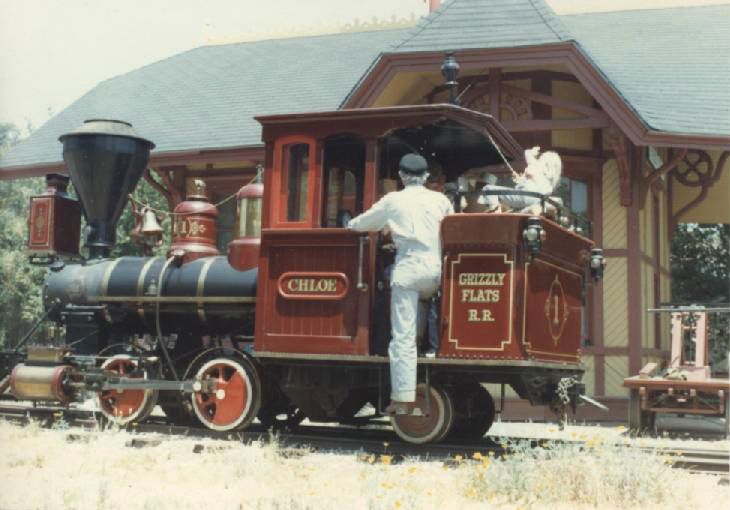
Above: The Kimball Family confers on the Chloe in front of the "So Dear To My Heart" train depot at Grizzly Flats. Ward Kimball is on the backside with conductors hat.Later on when Walt was building Disneyland and needed a station for Frontierland, He asked Ward if he could have it back for the new park. Ward had to finally tell Walt what happened to his original gift. So Walt had Ward dig out his original drawings and use those to duplicate the station in Frontierland along with a delivery station across the track. It's interesting as that station was also used as a model for our Euro Disneyland Frontierland "Thunder Mesa Station" , which opened in 1992. DLP's Frontierland Show Producer Jeff Burke, also had starred in a 1983 movie about 2 brothers in the Civil War for the American Adventure attraction movie in Florida's Epcot World Showcase which Ward was also working on and is a favorite of mine. The film also had a segment taken at "Grizzly Flats'" station. How great is that!
 Above: Grizzly Flats depot train signal suspended from side of station. Ward was setting it to show no stops for the race. 2 way Lantern on top is for night time use for stop or go on through.
Above: Grizzly Flats depot train signal suspended from side of station. Ward was setting it to show no stops for the race. 2 way Lantern on top is for night time use for stop or go on through.I invited Ward Kimball out to Disney's Tujunga facility in 1990 where I was staging all the DLP Frontierland Americana and had all the Railroad equipment I had collected for the train stations in that park. Of particular interest to Ward was a hand lever operated semaphore and chain ratcheted mail bag signal, which he thought would look good at "Grizzly Flats". He also liked the windmill with original steel bolted frame, oak banded water tank, and wood wheeled water wagon for the "Circle D Ranch". We exchanged windmill stories on how he obtained his and how mine came to be, and I guess you could say we covered everything from"Grizzly Flats" to DLP's Thunder Mesa".
Photographs property of John Patrick Burke
Pat Burke text: copyright Disney and more and John Patrick Burke
